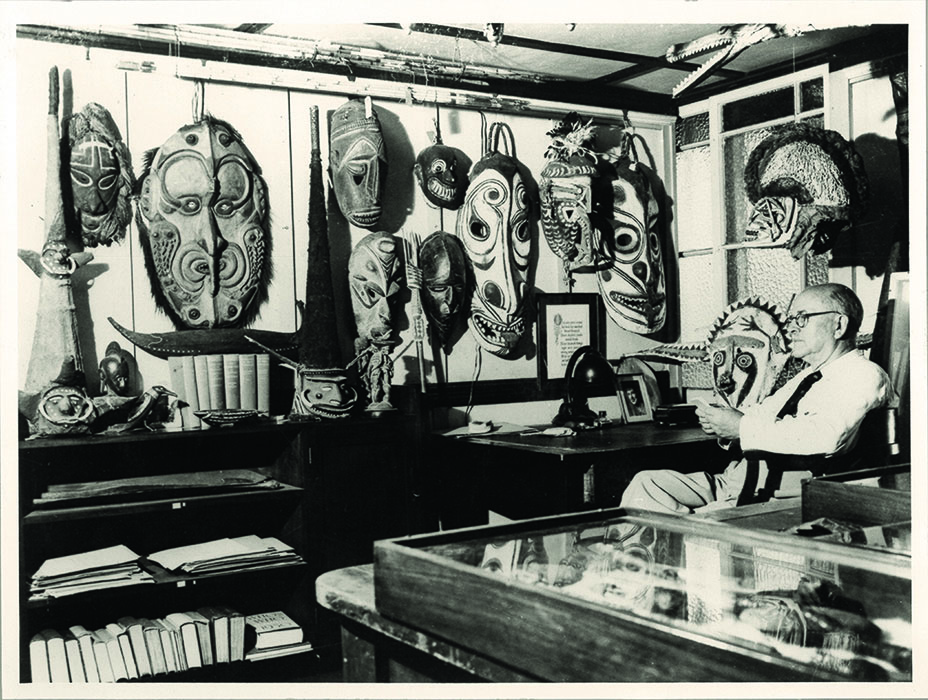The UQ Anthropology Museum houses a wealth of artefacts ranging from household implements to diverse performance paraphernalia and musical instruments. There are water-craft, paintings, clothing, hunting gear, a large quantity of stone tools, including grind stones and axes, and some 1,100 spears and arrows.
The Museum has been actively acquiring photographs since its inception. The photographic collection includes images from the early and mid twentieth century and includes fieldwork archives and mission photography. It is an important resource for, among others, family research, visual culture studies, histories of anthropology, native title research, cultural history and post-colonial studies.
The UQAM collection as a whole represents a rich seam in the late nineteenth and twentieth century social and cultural history of Australian Aboriginal and Pacific peoples. Many artefacts demonstrate the entanglement of missionaries, colonial officials and the indigenous inhabitants of a region. While collectors often sought to acquire objects that they thought represented the last genuine aspects of a cultural group, local people themselves creatively adapted their material culture using imported goods. The resulting complexity is a captivating aspect of many objects in the UQ Anthropology Museum and offers many opportunities for different kinds of research.
The Museum was formed in 1948 by Dr Lindsey Winterbotham’s donation of his own collection of over 1,000 objects, prior to the establishment of an Anthropology Department at the University. Added to over the years with bequests, donations, purchases and student and staff contributions, the Museum continues to grow.
The University of Queensland Anthropology Museum was established largely through the efforts of Dr Lindsey Page Winterbotham, a medical practitioner and lecturer in medical ethics. In 1948, the University formally accepted the donation of Winterbotham’s private collection of over 1,000 artefacts with a view to using it to support studies and teaching in anthropology, a discipline yet to be established in Queensland at that time. The appointment of Dr Winterbotham as Honorary Curator of Ethnological Specimens was confirmed by the University Senate in 1949.

Winterbotham’s collection formed the foundation of the Museum, its breadth reflecting his diverse interests. He collected not only the decorative or the ceremonial, but also things of everyday use and individual curiosity. His scientific interest in cultures across Indigenous Australia and Papua New Guinea included items of great craftsmanship and aesthetic quality. His initial collection was soon supplemented by a donation of 400 items from the Anthropological Society of Queensland.
Winterbotham spent the next ten years energetically building up a museum. Support came from a variety of sources, both from within the University and from the general public. Medical doctors, missionaries and government agents across Australia and the Pacific were approached to collect for the Museum. Advertisements run in local and state newspapers requesting donations also drew a substantial response; the Museum’s collection grew to over 10,000 items over a decade largely through public donations.
The initial allocation of three drawers in the School of Anatomy was insufficient to cope with the rapid influx of objects. Further space was designated for installation of public exhibitions, but it was only in 1957 that sufficient space became available to store the entire collection on campus. The Museum moved to its current purpose-built facilities in 1972.
The Museum quickly grew to be a unique resource beyond its initial intent. Under subsequent Directors the collection and exhibition program was broadened to represent dynamic contemporary Indigenous Australian and Pacific cultures. Substantial field collections by Museum and University researchers offered richer perspectives and opportunities for collaboration. Programs such as the Aboriginal Cultural Resource Unit, traineeships and artists-in-residence ensure that the cultural property held within the Museum remains accessible and connected to communities of origin.
Based on an unpublished history compiled by Annabelle Stewart-Zerba and Leo, D. 2008 “An Ark of Aboriginal Relics: The Collecting Practices of Dr L.P. Winterbotham”, in The Makers and Making of Indigenous Australian Museum Collections, eds, N. Peterson, L. Allen and L. Hamby, Melbourne University Press, Carlton.
General enquires
E anthmuseum@uq.edu.au
P +61 7 336 52674
F +61 7 336 51544
The UQ Anthropology Museum is an important resource for family research, visual cultural studies, native title research, cultural history and post-colonial studies. Your generous support plays a vital role in supporting the Museum's collections, exhibitions and programs.
Donations of $2 and over are tax-deductible in Australia.
The UQ Anthropology Museum respects your privacy and has adopted the University's policies on how your personal details are safeguarded. Please visit www.uq.edu.au/privacy for more information.
